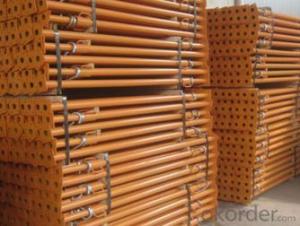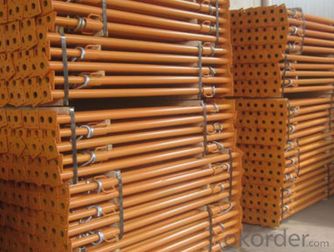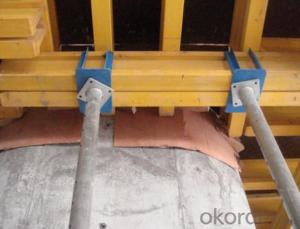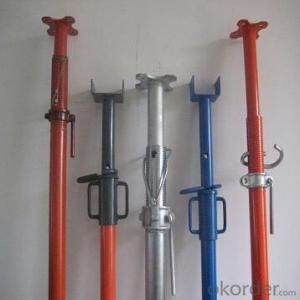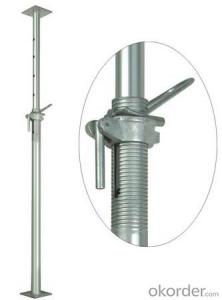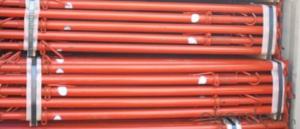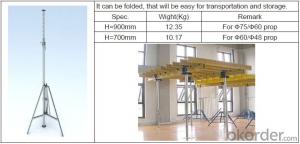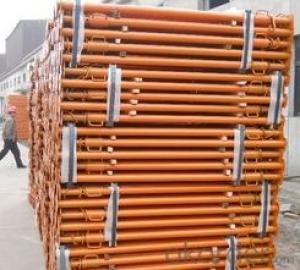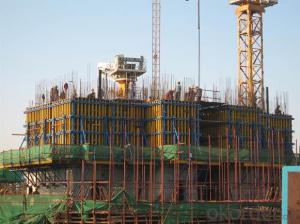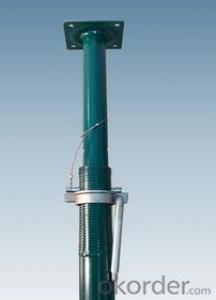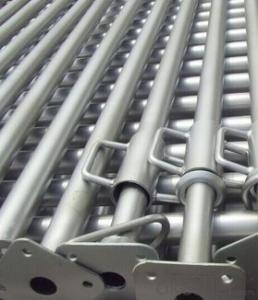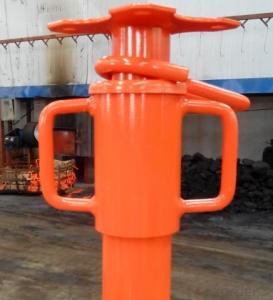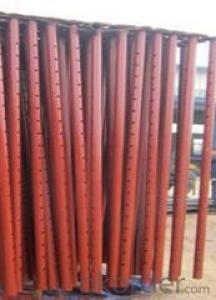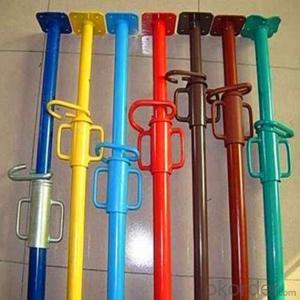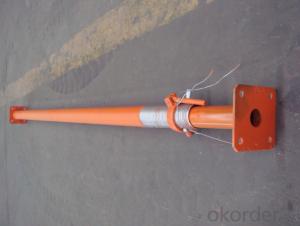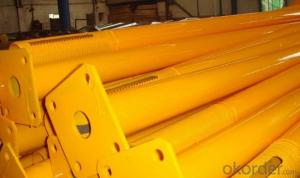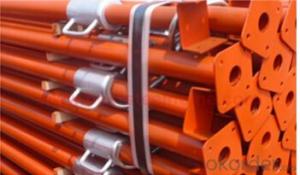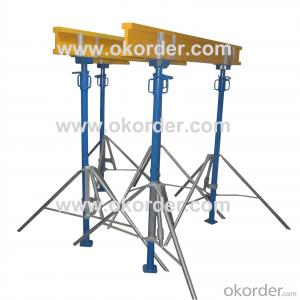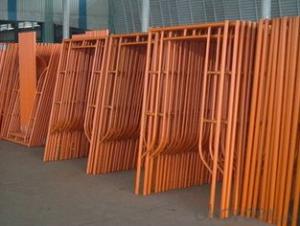Scaffolding Used Steel Props
- Loading Port:
- China Main Port
- Payment Terms:
- TT OR LC
- Min Order Qty:
- -
- Supply Capability:
- -
OKorder Service Pledge
OKorder Financial Service
You Might Also Like
Quick Details
| Type: | Scaffolding Part Type: | Material: | |||
| Surface Finish: | Adjustable Range: | Packing: | |||
| Payment Terms: |
Packaging & Delivery
| Packaging Detail: | In pallet, In bulks or as you like |
| Delivery Detail: | with 20 days after confirming the order |
Specifications
steel props
1.material: q235
2.type:light medium heavy duty prop, flower/cross/U base plate prop
3.surface: painted/gal
Scaffolding Used Steel prop
Product Description
1. Material: Q235 or Q255 or Q345
2. Surface Finish: painted, powder coated, zinc-plated, hot dip galvanization
3. Specification: light-duty, heavy-duty, U base type, cross type, italy type, american type, spanish type
4. Sizes:
5. Inspection: by ourselves or by SGS or B.V or others
6. Certificates: ISO9001, EN74, BS1139
7. Packing: inpallets
8. OEM service as avaliable
9. Samples we can offer
- Q: How do you ensure proper anchoring of steel props in sandy soil?
- To ensure proper anchoring of steel props in sandy soil, there are a few steps you can take: 1. Determine the load requirements: First, it is crucial to understand the load requirements of the steel props, including the weight they need to support. This will help you determine the appropriate anchoring method. 2. Choose the right prop design: Different prop designs offer various anchoring options. Select a prop design that is suitable for sandy soil conditions and has features like large base plates or flanges, which provide better stability and prevent sinking. 3. Dig deep holes: Digging deep holes in the sandy soil is necessary to create a stable foundation for the steel props. The depth will depend on the load requirements and the specific soil conditions. It is advisable to consult with a structural engineer or geotechnical expert for guidance on hole depth. 4. Compact the soil: After digging the holes, it is important to compact the soil at the base to increase its stability. This can be done using a compactor or by adding water and tamping the soil down firmly. 5. Use concrete footings: To reinforce the stability of the steel props, consider using concrete footings at the bottom of the holes. Pouring concrete into the holes and allowing it to set will provide additional support and prevent sinking or shifting. 6. Install proper bracing: Depending on the height and load requirements of the steel props, it may be necessary to install proper bracing to ensure stability. This can be achieved by using diagonal supports or cross bracing between props. 7. Regular inspections and maintenance: Regularly inspect the steel props and their anchoring system to ensure they remain secure and stable. Look for signs of sinking, shifting, or any issues that may compromise their integrity. Address any problems immediately to prevent accidents or structural failure. It is important to note that the specific requirements for anchoring steel props in sandy soil may vary depending on the project's scope, soil conditions, and local building codes. Therefore, it is always recommended to consult with professionals, such as structural engineers or geotechnical experts, to ensure proper anchoring techniques are employed.
- Q: What are the common quality control measures for steel props?
- There are several common quality control measures for steel props that are typically implemented to ensure the reliability and safety of these structural supports. These measures include: 1. Material Testing: One of the first quality control measures is to conduct material testing on the steel props. This involves examining the chemical composition, mechanical properties, and physical characteristics of the steel to ensure it meets the required standards and specifications. 2. Dimensional Inspection: Steel props need to be manufactured with precise dimensions to ensure proper fit and functionality. Dimensional inspection involves measuring the length, diameter, thickness, and other critical dimensions of the steel props to ensure they meet the specified tolerances. 3. Welding Inspection: Steel props are often assembled through welding processes. Quality control measures for welding include visual inspection of the welds to check for defects such as cracks, incomplete fusion, or porosity. Additionally, non-destructive testing methods like ultrasonic or X-ray testing can be used to detect internal defects in the welds. 4. Load Testing: Load testing is a crucial quality control measure for steel props as it ensures their strength and load-bearing capacity. Props are subjected to static or dynamic load tests, where they are loaded with weights or subjected to simulated operational conditions to verify their ability to withstand the intended loads. 5. Surface Coating Inspection: Steel props are often coated to provide protection against corrosion. Quality control measures for surface coatings involve inspecting the thickness, adhesion, and uniformity of the coatings, as well as conducting salt spray or other corrosion resistance tests to evaluate their durability. 6. Documentation and Traceability: It is essential to maintain comprehensive documentation and traceability throughout the manufacturing process. This includes recording all test results, certifications of materials used, and production details. This ensures that the steel props can be traced back to their source and any issues can be identified and addressed. By implementing these quality control measures, manufacturers can ensure that steel props meet the required standards and specifications, providing customers with reliable and safe structural supports for various applications.
- Q: What are the alternatives to steel props?
- There are several alternatives to steel props that can be used for supporting structures during construction or renovation projects. Some of these alternatives include: 1. Aluminum props: Aluminum props are lightweight and provide a high strength-to-weight ratio. They are easy to handle and transport, making them a popular choice for temporary support in construction projects. Additionally, aluminum props are resistant to corrosion, which makes them suitable for use in humid or coastal areas. 2. Timber props: Timber props, also known as wooden props, are a traditional and cost-effective alternative to steel props. They are commonly made from high-quality timber, such as hardwood, and can be easily adjusted to the required height. Timber props are lightweight, easy to handle, and can be used for various construction applications. 3. Adjustable telescopic props: Telescopic props are made from materials like aluminum or fiberglass and feature an adjustable length mechanism. They can be easily extended or retracted to fit the desired height and provide support for different types of structures. These props are commonly used in applications where variable heights are required or where space is limited. 4. Hydraulic jacks: Hydraulic jacks are another alternative to steel props and are often used for heavy-duty applications. These jacks use hydraulic pressure to raise and support heavy loads. They are commonly used in industrial settings or for lifting and supporting structures like bridges or buildings during construction or maintenance. 5. Screw jacks: Screw jacks are mechanical devices that use a threaded rod and a nut to provide support. They can be adjusted to the desired height by rotating the rod, allowing for precise leveling and support. Screw jacks are commonly used in applications where a stable and adjustable support system is required, such as in temporary structures or formwork. It is important to consider the specific requirements of the project and consult with a structural engineer or construction professional to determine the most suitable alternative to steel props based on factors such as load-bearing capacity, durability, and cost-effectiveness.
- Q: Are steel props suitable for supporting temporary seating structures?
- Temporary seating structures can be effectively supported by steel props. These props, also known as adjustable steel props or acrow props, are widely used in construction and temporary structures to provide stability and support. Their adjustable height feature makes them versatile and adaptable for various applications, including supporting temporary seating structures. By virtue of their durable steel construction, steel props offer a robust and dependable support system. They are capable of bearing heavy loads and can be easily adjusted to the desired height, thereby facilitating flexibility when setting up temporary seating structures. Furthermore, steel props are highly practical for temporary structures due to their ease of installation and removal. They can be swiftly assembled and disassembled, saving time and effort during the setup and dismantling process. Moreover, steel props guarantee a high level of stability and safety. Equipped with sturdy base plates, they provide a solid foundation and prevent sinking into the ground. This ensures the seating structure remains stable and secure, even when accommodating a large number of people. Overall, steel props are a suitable and reliable choice for supporting temporary seating structures. Their strength, adjustability, ease of installation, and stability make them an ideal support system that can withstand heavy loads and ensure the safety and comfort of users.
- Q: Are steel props suitable for supporting temporary staircases?
- Yes, steel props are suitable for supporting temporary staircases. Steel props provide stability, strength, and durability, making them a reliable choice for supporting various structures, including temporary staircases.
- Q: Can steel props be used in renovation projects?
- Indeed, renovation projects can make use of steel props. These props, also referred to as adjustable steel props or acrow props, find frequent application in construction and renovation endeavors for the purpose of supporting temporary loads. They offer temporary support to ceilings, walls, or beams during the course of renovations, repairs, or alterations. By virtue of their adjustable height, steel props suit a wide range of uses. Additionally, their installation, dismantling, and transportation are hassle-free, rendering them appropriate for renovation projects of both limited and extensive scope. Notably, steel props are engineered to possess strength and stability, thereby furnishing dependable support throughout the renovation process.
- Q: Can steel props be used for supporting temporary power generation infrastructure?
- Indeed, temporary power generation infrastructure can benefit from the utilization of steel props. Typically employed in construction endeavors to offer temporary support to structures, these props can also be effectively employed to support temporary power generation infrastructure. With adjustable height and effortless installation and removal, steel props prove to be a suitable option for temporary applications. Additionally, steel props boast robust load-bearing capacity, stability, and durability, all of which are fundamental prerequisites for supporting heavy power generation equipment. Whether it involves supporting a generator or stabilizing temporary power poles, steel props possess the capability to provide the requisite support and stability required by temporary power generation infrastructure.
- Q: Can steel props be used in construction of retaining walls?
- Retaining walls can indeed incorporate steel props into their construction. Termed as steel shores or steel acrows, these props find wide usage in the construction industry, serving as temporary supports at various stages of the building process. For the erection of a retaining wall, steel props offer invaluable assistance by providing structural support during construction, ensuring stability and averting potential collapse. Thanks to their adjustable nature, these props can be set at the desired height and angle, delivering adequate support. Additionally, their durability and ability to withstand heavy loads make them ideal for bearing the weight of retaining walls. Nonetheless, it is crucial to design and engineer both the retaining wall and the utilization of steel props in accordance with the specific requirements and conditions of the project, as different retaining wall designs may necessitate distinct support systems.
- Q: How do you prevent steel props from sinking in wet soil?
- One method to prevent steel props from sinking in wet soil is by using a steel base plate or a larger wooden base to distribute the weight over a larger surface area. This helps to increase the stability and reduce the pressure on the soil, preventing the props from sinking. Additionally, adding gravel or crushed stone underneath the base can improve drainage and further prevent sinking in wet soil conditions.
- Q: How do steel props contribute to the safety of workers on construction sites?
- On construction sites, steel props are indispensable safety tools that are vital for the protection of workers. These adjustable steel tubes fulfill a critical function by providing support for various structures, preventing potential collapses or falls. Let's explore the ways in which steel props contribute to worker safety: 1. Structural stability: Steel props offer essential support to construction elements like walls, beams, and ceilings. Their presence ensures stability, minimizing the risk of accidents and injuries caused by structural failures or collapses. 2. Even load distribution: Designed to bear heavy loads, steel props distribute weight evenly, preventing excessive strain on construction elements. This feature guarantees the stability and security of structures, reducing the likelihood of accidents resulting from overloaded or weakened elements. 3. Height adaptability: Steel props can be easily adjusted to different heights, allowing workers to maintain the desired level of support as construction progresses. This adaptability ensures the ongoing stability and safety of structures throughout the building process. 4. Secure anchoring: Steel props are typically securely anchored to the ground or other stable surfaces, providing an additional layer of support and stability. This prevents unexpected movements or shifts, minimizing the risk of accidents and injuries for workers in the vicinity. 5. Versatility: Steel props find application in various construction scenarios, including formwork support, temporary shoring, and scaffolding. Their versatility makes them invaluable tools for ensuring safety in different construction projects, enabling workers to address specific safety requirements on-site. 6. Compliance with safety regulations: Safety regulations and building codes often mandate the use of steel props. By adhering to these regulations, construction companies reinforce safety measures, reducing the risk of accidents and potential legal liabilities. In summary, steel props are essential for safeguarding workers on construction sites. By providing structural support, even load distribution, height adaptability, secure anchoring, versatility, and compliance with safety regulations, steel props significantly decrease the risk of accidents and injuries stemming from structural failures or collapses.
Send your message to us
Scaffolding Used Steel Props
- Loading Port:
- China Main Port
- Payment Terms:
- TT OR LC
- Min Order Qty:
- -
- Supply Capability:
- -
OKorder Service Pledge
OKorder Financial Service
Similar products
Hot products
Hot Searches
Related keywords
